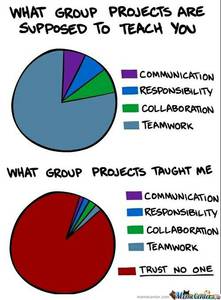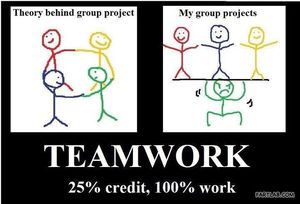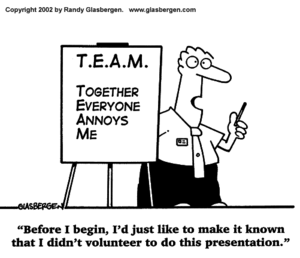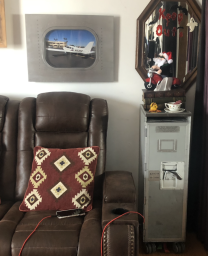
Adobe Acrobat document [2.2 MB]
Adobe Acrobat document [86.1 KB]
Microsoft Word document [75.0 KB]
Adobe Acrobat document [423.2 KB]
Adobe Acrobat document [5.3 MB]
More awesome videos like the above may be found here
University of Minnesota group work page
Purdue University - Cooperative and Collaborative Learning
Why group formation is key to successful collaborative learning - Dr. Battaglia, ERAU, 2016
- benefits of group work:
a. 80% of all employees in America work in teams or groups
b. group work allows for both cooperation and competition
c. increased student engagement
d. greater student ownership and greater course satisfaction
e. enhanced independent thinking
f. deeper learning
g. application of knowledge
h. greater retention of information
i. groups stimulate creativity
j. groups have more information than a single individual
- cooperative learning: (and collaborative, as the terms are often used interchangeably in the literature) is an approach to teaching that departs from the traditional lecture-base format
Slavin (1983, p. 3) defines it as: "a set of task structures that require students to spend much of their class time working together in 4-6 member heterogeneous groups. They also use cooperative incentive structures, in which students earn recognition, rewards, or (occasionally) grades based on the academic performance of their groups."
- most common strategies used to form student groups:
1. students form their own groups
2. instructors form the groups
- groups assigned by the instructor perform better than self-selected groups
- randomized methods: playing cards, candy, birthdays
- designed heterogeneous grous: academic ability, cultural backgrounds, gender, leaders and followers, introverts and extroverts
3. groups are randomly generated
- keys for long-term group success:
A. Accountability
1. team policy statement
2. accountability mechanism: workplace progressive discipline policy (group warning, instructor warning, termination)
B. Interdependence
1. designated group roles: discussion facilitator, timekeeper/task master, recorder/summarizer, reporter/spokesperson
2. assigning team roles
- managing group accountability and interdependence: weekly progress reports va canvas (objectives for the week, who attended the meetings, what the group discussed, accomplishments that week)
- group assignments: use rubrics!
- 6-3-5: 6 people in group - 3 ideas of each person in group - takes 5 minutes to do
Microsoft Word document [49.1 KB]
Microsoft Word document [30.0 KB]
Microsoft Word document [69.5 KB]
Collaborative Learning
To collaborate - to work with another or others - means students working in pairs or small groups to achieve shared learning goals - learning through group work rather than alone.
Other terms - cooperative learning - team learning - group learning - peer-assisted learning.
Features - intentional design (learning is structured) - co-laboring (all participants must contribute more or less equally) - meaningful learning (students must increase their knowledge or deepen their understanding)
Subtle difference between cooperative and collaborative learning - whereas the goal of cooperative learning is to work together in harmony and mutual support to find the solution, the goal of collaborative learning is to develop autonomous, articulate, thinking people, even if at times such a goal encourages dissent and competition that seems to undercut the ideals of cooperative learning.
Types of groups:
1. Formal - last from one class period to several weeks - whatever it takes to complete a specific task or assignment - purpose is to accomplish shared goals, to capitalize on different talents and knowledge of the group, and to maximize the learning of everyone in the group.
2. Informal - temporary groups that last for only one discussion or one class period - purpose is to ensure active learning
3. Base - long-term groups with a stable membership, more like learning communities - purpose is to provide support and encouragement and to help students feel connected to a community of learners
5 ELEMENTS ESSENTIAL FOR COOPERATIVE LEARNING GROUPS
1. Positive interdependence: success of individuals is linked to success of the group
2. Promotive interaction: students are expected to actively help and support one another - members share resources and support and encourage each other's efforts to learn
3. Individual and group accountability: group is held accountable for achieving its goals - each member is accountable for contributing his or her share of the work - students are assessed individually
4. Development of teamwork skills: students are required to learn academic subject matter (task work) and also to learn the interpersonal and small-group skills required to function as part of a group (teamwork)
5. Group processing: students should learn to evaluate their group productivity - to describe what member actions are helpful and unhelpful - to make decisions about what to continue or change
Schema: cognitive structure that consists of facts, ideas, and associations organized into a meaningful system of relationships.
Taxonomy of collaborative skills
- interpersonal skills
- group management skills
- inquiry skills
- conflict resolution skills
- synthesis and presentation skills
|
TRADITIONAL CLASSROOM student role |
COLLABORATIVE CLASSROOM student role |
|
Listener, observer, note taker |
Active problem solver, contributor, discussant |
|
Low or moderate expectations of preparation for class |
High expectations of preparation for class |
|
Private presence in classroom with few or no risks |
Public presence with many risks |
|
Attendance dictated by personal choice |
Attendance dictated by community expectation |
|
Competition with peers |
Collaborative work with peers |
|
Responsibilities and self-definition associated with learning independently |
Responsibilities and self-definition associated with learning interdependently |
|
Seeing teachers and texts as the sole sources of authority and knowledge |
Seeing peers, self, and the community as additional and important sources of authority and knowledge |
MacGregor (1990, p.25)
For effective collaborative work, group size usually ranges from 2 – 6 students.
Try not to change group memberships, but keep them intact as long as possible, as groups take time to mature, and some of the most valuable learning experiences come from learning to work through difficult disagreements.
Research supports heterogeneous grouping because working with diverse students exposes individuals to people with different ideas, backgrounds, and experiences.
Additionally, diverse groups are more productive and better suited for multidimensional tasks.
There are, however, disadvantages:
1. Students can be uncomfortable with the diversity of opinion and the possible tension that results from disagreement.
2. Distributing minority or female students among groups to achieve heterogeneity can isolate them, putting them into the position of being the sole representative of their group.
3. When academic achievement is used to create a heterogeneous group, there may be insufficient opportunities for low achievers to show leadership and not enough contact between high achievers.
Homogeneous groups offer advantages:
1. Students who share common characteristics may feel sufficiently at ease with each other to discuss or explore highly sensitive or personal issues.
2. These groups may also master most efficiently highly structured skill-building tasks.
3. These groups may be good for language learning or other specific content mastery where group reinforcement of similar knowledge or skill is important.
4. Students tend to prefer working with students similar to themselves, and hence satisfaction with collaborative learning often increases.
The greatest disadvantage:
Students do not experience the rich interactions and exchange that can occur working with a diverse group of peers.
3 METHODS FOR ASSIGNING GROUP MEMBERSHIP
1. Random: quick, efficient, fair, good for informal groups for short-term assignments
- Free-form – walk among pointing by random selection
- Odd-Even – walk up classroom aisles saying odd, even – then odds turn around and talk to evens
- Count off – one through however many you want in group, then ones together, twos together etc.
- Numbered slips of paper – from hat or just distribute
- Playing cards – four people per group - like Aces, Kings, etc. and to spice things up a Joker can go with any group of their choosing
- Created cards – with A-1 for group A member 1 etc. or use other creative ways to identify teams
- Line up and divide – in order of birthdays, last names alphabetically, height, etc.
- Jigsaw match-ups – find number of pictures, tear up and ask students to find others with matching pieces
- Text match-ups – use a line from some text to have students find partners with matching text
2. Student selection: fast, efficient, students are more comfortable, and thus motivated, but based on friendships so may cause outsiders, or students straying off task
- Free-form – just set number per group
- Group leader choice – assign student leaders, then let them choose groups, may give criteria
- Team hiring – set up team hiring method, some students are employers, others make resumes, a hiring budget is given too
3. Instructor determined: useful for motivating students, but may reinforce homogeneity and students may not be comfortable airing publicly their views on certain topics (stratification is when you select membership based on student characteristics where you organize students in layers then use this information to create groups)
- Show of hands – have students raise hands to respond to questions then assign groups based on responses
- Student sign-up – choose topics to investigate, write on sheets, post around room, and allow students to sign up for preferences
- Single-statement Likert Scale Rating – prepare a statement on issue, ask students to circle 1-5 on Likert Scale, and then batch all ones together, two etc. for homogeneous groups, or batch a 1, a 2, a 3, a 4, and a 5 together for heterogeneous groups
- Corners – design a type of characteristic or interest for each of 4 corners of room, ask students to identify with a corner, then for homogeneous keep corners together, for heterogeneous pick one from each corner
- Essay – students write essay on controversial issue – batch by answers
- Data Sheet – use data to select homogeneous or heterogeneous groups
- Course-based test scores – use pretest or recent scores to form groups based on level of knowledge
- Learning style – personality or learning style inventory (using Myers-Briggs etc.)
- Discipline-Related Products – groups formed based on product, achievement
- College-based Achievement Ranking – past grades, standardized exams, entrance exams, etc.
Assign roles to each group member – gives each student a purpose for participating and encourages interdependence, thus improving group processes – use count-off to assign roles or playing cards
|
FACILITATOR |
Moderates team discussion Keeps group on task Ensures everyone assumes their share of work Makes sure all have opportunity to learn, participate, earn others’ respect
|
|
RECORDER |
Records assigned team activities Takes notes summarizing discussion Keeps all necessary records, attendance, check-offs Completes worksheets, written assignments, for submission to instructor
|
|
REPORTER |
Serves as group spokesperson Orally summarizes group’s activities, conclusions Assist recorder with preparations of reports, worksheets
|
|
TIMEKEEPER |
Keeps group aware of time constraints Works with facilitator to keep all on task Can assume role of missing group member Responsible for any set-up needed Responsible for cleanup after session ends
|
|
FOLDER MONITOR |
If group work folders are used, picks up folder, distributes material, returns all papers, assignments, notes to team members Ensures all relevant class materials are in folder at end of session
|
|
WILDCARD |
Assumes role of any missing member of fills in as needed
|
Microsoft Word document [30.0 KB]
University of Minnesota - Center for Educational Innovation - Surviving Group Projects
2 most critical elements in constructing collaborative learning:
- Designing an appropriate learning task
- Structuring procedures to engage students actively in performing that task
|
QUESTION TYPE |
PURPOSE |
SAMPLE TASK PROMPTS |
|
Exploratory |
Probe facts and basic knowledge |
What research evidence supports…? |
|
Challenge |
Examine assumptions, conclusions, and interpretations |
How else might we account for…? |
|
Relational |
Ask for comparison of themes, ideas, or issues |
How does ____ compare to ____? |
|
Diagnostic |
Probe motives or causes |
Why did ____? |
|
Action |
Call for a conclusion or action |
In response to ___, what should ___do? |
|
Cause and effect |
Ask for causal relationships between ideas, actions, or events |
If ____ occurred, what would happen? |
|
Extension |
Expand the discussion |
What are additional ways that ___? |
|
Hypothetical |
Pose a change in the facts or issues |
Suppose ___ had been the case, would the outcome have been the same? |
|
Priority |
Seek to identify the most important issue |
From all that we have discussed, what is the most important ___? |
|
Summary |
Elicit synthesis |
What themes or lessons have emerged from ___? |
|
Problem |
Challenge students to find solutions to real or hypothetical situations |
What if? (To be motivating, students should be able to make some progress on finding a solution, and there should be more than one solution) |
|
Interpretation |
Help students to uncover the underlying meaning of things |
From whose viewpoint or perspective are we seeing, hearing, and reading? What does this mean? What may have been intended by …? |
|
Application |
Probe for relationships and ask students to connect theory to practice |
How does this apply to that? Knowing this, how would you…? |
|
Evaluative |
Require students to assess and make judgments |
Which of these are better? Why does it matter? So what? |
|
Critical |
Require students to examine the validity of statements, arguments, and conclusions and to analyze their thinking and challenge their own assumptions |
How do we know? What is the evidence? How reliable is the evidence? |
|
Bloom’s taxonomy KNOWLEDGE Remembering previously learned material (definitions, principles, formulas) |
Task Prompts Define Recall Recognize Remember Who What Where How When |
Round Robin: students in each group speak, moving from one to the next Note-taking pairs: students work together to create an improved, partner version of their notes Group Grid: students in groups place information into blank cells of a grid
|
|
COMPREHENSION Involves understanding the meaning of remembered material (restating or citing examples) |
Task Prompts Describe Compare Contrast Rephrase Put in your own words Explain the main idea |
Think-Pair-Share: students think individually, then pair up with classmate and discuss before sharing with entire class Team matrix: students team up and discriminate between similar concepts by noticing and marking on a chart Dialogue journals: record thoughts in journal and share with peers for comments and questions |
|
APPLICATION Using information in new contect to solve a problem, answer a question, or perform a task |
Task Prompts Apply Classify Use Choose Write an example Solve
|
Buzz Groups: form small groups and ask to discuss questions Role Play: create scenario, ask students to act out or assume identities that require them to apply knowledge, skills, or understanding Think-Aloud Pair Problem Solving (TAPPS): students take turns solving problems aloud as their partners listen |
|
ANALYSIS Thinking critically and in depth Breaking a concept into its parts Explaining interrelationships Distinguishing relevant from extraneous material |
Task Prompts Identify motives/courses Draw conclusions Determine evidence Support Analyze Why does this happen? |
Critical debates: form teams, analyze issue, develop arguments, determine evidence, debate Learning cell: develop questions about reading assignment/learning activity, then form pairs, have students answer their partners’ questions Word webs: students analyze a course-related concept by generating list of related ideas and organizing into a graphic or using lines to represent connections |
|
SYNTHESIS Putting parts together to form a new whole Solving a problem requiring creativity or originality |
Task Prompts Predict Produce Write Design Develop Synthesize Construct How can we improve What would happen if Can you devise How can we solve |
Analytic teams: form teams and ask individuals to perform component tasks of an analysis Group investigation: have student teams plan, conduct, and report on an in-depth project Team anthologies: have student teams compile and annotate an anthology (collection) of course-related materials |
|
EVALUATION Using a set of criteria to arrive at a reasoned judgment of the value of something |
Task Prompts Evaluate Assess Appraise |
Three-step interview: have student pairs take turns interviewing each other, asking questions that require a student to assess the value of competing claims, then make judgment as to best Jigsaw: form small groups, ask students to develop knowledge about a given topic and formulate the most effective ways of teaching it to others Paper seminar: assign individual students to write an original paper and then present to small group for feedback and discussion |
Teachers know how well students are learning using Classroom Assessment Techniques (CATs)
Identifying goals is an important starting point for assessing student learning. In an effort to help teachers identify, clarify, and rank teaching goals, Angelo and Cross developed self-scorable Teaching Goals Inventory (TGI)
Adobe Acrobat document [15.9 KB]
Facilitating student collaboration
- Introducing the activity
- Explain the activity
- Clarify the objectives
- Outline the procedures
- Present examples if needed
- Remind groups of the rules for group interaction
- Set time limits
- Provide the prompt
- Query the students for understanding, and let students ask questions
- Observing and interacting with groups
- Be available to clarify instruction, review procedures, and answer questions about the assignment
- Paraphrase or ask a question to clarify what a student has said
- Compliment the student on an interesting or insightful comment
- Elaborate on a student’s statement or suggest a new perspective
- Energize by using humor or by asking for additional contributions
- Disagree with a student comment, but be gentle
- Mediate between students
- Pull together ideas by pointing out relationships
- Summarize the group’s major views
- Addressing problems
Group decision-making techniques
|
Authority |
Group generates ideas – holds open discussions One person (leader) makes decision Quick technique but does not maximize strengths of individuals and group may not be motivated to implement decision made by one person |
|
Majority |
Period of discussion – vote – majority wins Relies on democratic process Majority overwhelming minority views may encourage factionalism |
|
Negative minority |
Group holds vote for most unpopular idea – eliminates it – votes again until only one idea is left Democratic – can build consensus – but time consuming – members could feel resentful if their idea was unpopular |
|
Consensus |
Group discuses – negotiates till everyone understands and supports decision All members have opportunity to express themselves and influence decision May be difficult to reach consensus and extremely time consuming |
|
Using criteria |
Participants explore, identify, agree on criteria for successful solution – evaluate alternatives against these criteria Objective measure of quality to solution but may be difficult to come up with appropriate criteria |
|
Compromise |
Groups create compromise decision rather than single decision that excludes other decisions Implementation may take longer as more than one idea is considered |
- Inequitable participation: address over- or under-participation using
- Think-pair-share
- Affinity grouping
- Talking chips
- Round Robin
- Student resistance to group work: find out reason – involve student in making group ground rules – consider using
- Analytic teams
- Paper seminar
- Off-task behavior: by two or more students socially
- Groups that don’t get along: first allow them time to work it out, then ask them to identify issue, and finally work with them to resolve. As a last resort reorganize groups.
- Several or no students want to assume leadership: effective leaders are able to share leadership and help others succeed – also important to be a good follower – in the case of no one wanting to assume role – flip a coin or take turns
- Different ability levels: we all have different gifts
- Linguistically intelligent
- Logistically-mathematically intelligent
- Spatially intelligent
- Bodily-kinesthetically intelligent
- Musically intelligent
- Interpersonally intelligent
- Naturalistically intelligent
Techniques that work include:
- Fishbowl
- Jigsaw
- Think-Pair-Share
- Role Play
- Groups that work at different rates: set time limit and make it public – assign timekeeper
- Attendance issues: address issues individually and allow alternative solutions for genuine reasons
- Cheating: delineate the different between cheating and collaborating – consider using:
- Group investigation
- Round robin
- Buzz groups
- Documented problem solutions
- Reposting out techniques: valuable closing stage because:
- Enhances learning when others share their learning
- Students begin to own knowledge
- Helps them reinforce ideas hearing from others of similar ideas
- Recurring themes reinforces they are on right track
- Can reveal omissions so they can fill learning gaps
Activities include:
- Stand up and share: each round only shares new info
- Symposium, Colloquium, Panel, Seminar: presentation followed by discussion
- Simulated business meeting: presenting to a board using multimedia
- Team rotation: Team A moves to Team B to present ideas while members of Team B listen and ask questions – then they reverse roles
- Three stay one stray: Person from Team A is designated to move to Team B to report while other team members remain behind to hear from a traveling team member from Team C
- Rotating trios: from a group of 4, one stays behind as group expert while other 3 move to new station to learn from another group – student stays behind for only one rotation
- Poster session: small groups make posters, then pin on wall, all students walk around and view other people’s posters
- Small group stations: Instructor sets up several stations, teams walk around, view issue, discuss, then post response, finally individual students move from station to station to read all responses
- Helping groups achieve closure: to see connections and synthesize information - try using:
- Think-Pair-Share
- Note-taking pairs
- Test-taking teams
- Sequence chains
- Word webs
- Dialogue journals
Instructor synthesis can be effective too:
- Summarize salient points and recurring themes from group reports
- Clarify details
- Point out misconceptions or inaccurate reports
- Add information where omissions occurred
- Address any unanswered or nagging questions
- Point out implications
- Help make connections to previous content and content not yet addressed
- Review objectives with the group
- Helping students celebrate their achievements: part of debriefing process – recognizes positive experiences and gains in learning – public notice of students achievements
- Gallery of achievement: groups list accomplishments – post on wall – as people walk through they place a check mark next to what applies to them – note any unusual or unexpected accomplishments
- Group photo
- Party with food – potluck or pizza
Grading and evaluating Collaborative Learning
1. Ensuring individual accountability and positive group interdependence: grades must reflect an individual and a group grade – consider using
a. Test-taking teams: first teams study a unit together – then bring list of questions they expect to be on the exam – then individual students take teacher-prepared exam for individual grade – teams discuss and submit team responses on test for group grade – students receive combination of individual (2/3) and group (1/3) scores
b. Group grid: to help students organize and classify information visually – for individual accountability use different colored pens for each student
c. Dialogue journals: divide page vertically – on left student records his or her notes – on the right partner writes in comments – both sides are graded
2. General guidelines for grading collaborative work: not every activity needs to be graded and not every activity needs to be collaborative – some guidelines for teachers:
- Appreciate the complexity of grading (flaws and constraints)
- Recognize that there is no such thing as absolutely objective evaluation
- Distribute time effectively
- Be open to change
- Listen to and observe students
- Be very clear and explicit about meanings attached to grades
- Communicate and collaborate with students
- Integrate grading with other key processes
- Seize the ‘teachable moment’
- Make student learning the primary goal
- Be the teacher first, a gatekeeper last
- Encourage learning-centered motivation
3. Important decisions in grading collaborative work
a. Deciding what to evaluate (student achievement and student participation)
b. Deciding whether to evaluate for formative or summative purposes
Formative: to provide teachers and students with information on how well students are learning in order to help them improve – almost never graded – aim is to educate and improve student (or teacher) performance not to audit it
Summative: gather evidence to assign grades that becomes course grade and is reflected on transcript
c. Deciding who does the evaluating
- Instructor
- Student self-evaluation
- Student peer-evaluation
- Group evaluation
Contact Me
Sarah Nilsson, J.D., Ph.D., MAS
602 561 8665
You can also fill out my
Get Social with Me
Legal Disclaimer
The information on this website is for EDUCATIONAL purposes only and DOES NOT constitute legal advice.
While the author of this website is an attorney, she is not YOUR attorney, nor are you her client, until you enter into a written agreement with Nilsson Law, PLLC to provide legal services.
In no event shall Sarah Nilsson be liable for any special, indirect, or consequential damages relating to this material, for any use of this website, or for any other hyperlinked website.
Steward of
I endorse the following products
KENNON (sun shields)












